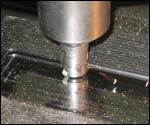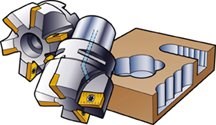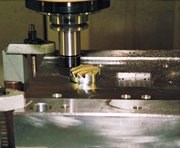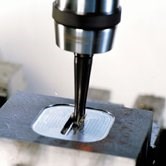Milling Advances Increase Productivity
Keeping on top of new advances in cutting tools can keep moldmakers profitable.
Today's moldmakers face conflicting technical and business challenges, and new tooling developments can solve many of them. Milling pre-hardened dies and molds to tighter tolerances generally slows down throughput of cutting tool feeds and speeds and lengthens machine cycle times. Demands for tighter tolerances and higher quality levels can lengthen machining times and slow production. At the same time, global competition demands greater throughput and shorter leadtimes for mold shops to survive. Advanced milling tools are essential for moldmakers to conquer hard materials, become more productive and stay in business. However, knowing what technology yields the greatest payoff and how to make the best of it takes the assistance of a knowledgeable tool supplier.
Mold and die work is characterized by short runs and precise tolerances. Shop managers typically take a conservative approach to material removal tooling in order to keep from risking damage to expensive workpieces. With offshore competition adding pressure to reduce costs, it's easy to stick with your old tools and reduce feeds and speeds to mill pre-hardened components. The trouble is, tooling costs typically account for just three percent of overall component costs, and old tools make you less competitive. Modern mold machining tools, which cost very little in the big picture, remove metal up to 10 times faster than old ISO-style cutters and more than pay for themselves in enhanced productivity. Advances in milling tools, cutting inserts and milling software can help you reclaim costly machine time, exploit profitable niche markets and stay competitive.
A Different Approach
New tools can open up machining alternatives that boost productivity. A plunge cutter, for example, rough-cuts larger dies and molds up to four times faster than common shoulder mills or endmills (see Figure 1). Unlike a shoulder mill working its way along the edge of the workpiece, the plunge mill penetrates straight down into the edge of the workpiece. The strong cutter with its large flutes eases chip evacuation, allowing quick removal of large amounts of metal. Significantly, it cuts faster without making excessive horsepower demands on today's typically more accurate but less powerful milling machines. The plunge cutter also directs cutting forces straight back into the spindle to minimize wear and tear on expensive machines.
One stamping die maker found profiling D2 steel blocks with a 2.5-inch diameter, 7.0-inch long helical cutter strained a 30 hp vertical milling machine. To stay within available power limits, the helical cutter could penetrate just 1.25 in. radially. With very slow feedrates - less than 3.0 ipm - the conventional tool required three passes to profile each 30-inch long block. Overall cycle time was more than two hours. A plunge cutter with modular extensions made a 2.8 in. wide plunge cut at 15 in./minute. It reduced machining time 40 percent, yet stayed comfortably within machine horsepower limits. In addition, the plunge cutter used just four insert edges to complete the profile. The helical cutter needed 30 insert edges to achieve the same result. Compared with the helical cutter, the rigid plunge cutter also made a straighter wall that required less finishing to achieve final dimensions.
Hard Work
Steel alloys for many die and mold applications are now machined at a higher hardness level. While tool steels were once considered hard at 45 Rockwell C (Rc), steels machined at 63 Rc are now common. Moldmakers who once cut deep pockets only in "green" stock are now machining tool steels in a fully hardened state to avoid subsequent heat treating distortion and reduce overall leadtimes. Machining in a hard condition also ensures better quality with less costly grinding and polishing time.
For all the advantages of hard-part machining, the heat and pressure encountered when milling hardened alloys causes rapid failures in conventional carbide cutting inserts. There is now a new type of carbide insert that has been developed specifically for machining hardened steel alloys at elevated cutting speeds (see Figure 2). In one big semi-finishing operation on 46 to 50 Rockwell steel, these inserts in a facemill reduced cycle time by half. Steel slabs 10 ft. long by 5 ft. wide by 15 in. thick required semi-finishing cuts all over to achieve tolerances within 0.005 to 0.010 in. With these new carbide inserts, surface speed doubled from 60 to 120 sfm, and overall milling time fell from 50 hours to just 25.
In another shop that makes a range of molds for the computer, automotive and other industries, indexable insert endmills replaced high-speed cutters. The freer-cutting tools increased machine speeds at least 30 percent and feeds 25 to 30 percent to reduce machining time dramatically.
To a greater extent than general-purpose milling operations, moldmakers rely on small-diameter profiling tools to reach deep into cavities. Larger cutters (diameter 2" and above) commonly use rigid toolholders, extensions and reducers to extend their reach and hold tight tolerances. In contrast, smaller tools (diameter 1.5" and under) have commonly used welded extensions and other hand-made adaptations for long reach applications. These tend to introduce runout that degrades accuracy and part quality. New threaded couplings now enable cutters from 3/8 to 1.5 in. diameter to reach into deep mold pockets with strong and accurate modular extensions.
Tight Niche
Moldmakers trying to cut costs for plastic molders and other specialty markets routinely combine multiple small part cavities in a single mold. To reduce mold leadtimes, manufacturing engineers also want to mill small, detailed cavities rather than burn them in with EDM. Molds can be produced faster and cheaper without sending work to outside EDM shops, machining EDM electrodes or moving molds from one machine to another. However, milling intricate mold details accurately requires small and precise cutting tools with negligible runout.
New carbide endmills have been developed specifically to finish fine die and mold details in steel 52 Rockwell and harder (see Figure 3). The solid carbide endmills come in diameters down to 0.4 mm (0.016"), with a large central core to overall diameter ratio. This ratio maximizes rigidity and minimizes deflection. Compared with standard endmills optimized for soft steel, the new endmills have negative rake geometry and reinforced edges to better withstand hard machining stresses. An advanced heat-resistant coating protects the fine-grained carbide substrate. In hard materials, the new tools typically increase speeds and feeds 20 percent as compared with previous solid carbide cutters.
Alternatively, other solid carbide endmills can last twice as long as common carbides in order to extend productive machining time between tool changes. In one die making application that involved cutting steel with greater than 62 Rockwell hardness, these endmills lasted 20 percent longer than common carbide cutters. The cumulative savings in tool costs and machine time totaled more than $17,000 over a run of 3,000 parts.
Smart Machining
Today's sophisticated machining software provides opportunities to incorporate more productive and efficient toolpaths into your moldmaking routines (see Figure 4). However, the most productive software has to integrate optimum tool feeds and speeds into those complex milling routines. Trial-and-error programming puts molds, tools, machines and schedules at risk. Integrated tooling and software can get die and mold processes up and running quickly, without scrap.
How can mold and die makers keep up with rapid milling developments? Check to see if your supplier offers training or improvement programs. Take advantage of what they may offer as the benefits have been shown to include savings in machining time, maintenance, repair, operating costs and tool inventories.
New tools and insight can help die and moldmakers overcome today's technical and business challenges. With your competitiveness and your business at stake, it pays to ask for them.
Related Content
Solving Mold Alignment Problems with the Right Alignment Lock
Correct alignment lock selection can reduce maintenance costs and molding downtime, as well as increase part quality over the mold’s entire life.
Read MoreHow to Eliminate Chatter
Here are techniques commonly used to combat chatter and guidelines to establish a foundation for optimizing the moldmaking process.
Read MoreMachine Hammer Peening Automates Mold Polishing
A polishing automation solution eliminates hand work, accelerates milling operations and controls surface geometries.
Read MoreRead Next
Ceramic Cutting Tools: A Cut Above
Continuous machining with new ceramic mill reduces machining time by 88 percent—saving time and money.
Read MoreHow to Use Continuing Education to Remain Competitive in Moldmaking
Continued training helps moldmakers make tooling decisions and properly use the latest cutting tool to efficiently machine high-quality molds.
Read MoreHow to Use Strategic Planning Tools, Data to Manage the Human Side of Business
Q&A with Marion Wells, MMT EAB member and founder of Human Asset Management.
Read More

























